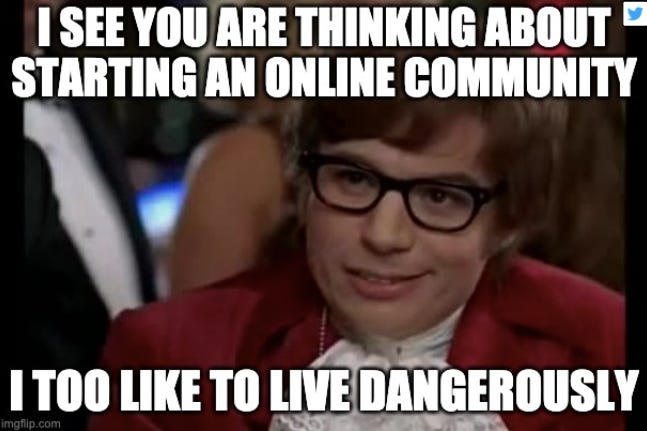The Structure of Brand Communities
Centralized vs Decentralized
There are two main forms that brand communities tend to take: Centralized or Decentralized. (Remember, we’re not talking about social media communities here. See this post for reference.)
Centralized: There is one digital destination that all community members join. Most often this is linked to a brand’s website or app.
Decentralized: The brand has many communities spread out over various platforms.
Each of these comes with advantages and disadvantages, so let’s get into them:
Centralized
Advantages:
All members of the community are part of ONE digital space, meaning that every member gets the same opportunity to view/read the content, ask questions, learn about community events, earn incentives, etc. in one shared space.
Operationally, this saves time for the Community team as they only have to manage this one space. Think of everything that goes into that: platform updates, features/functionality, collecting metrics, and more.
Disadvantage:
Sometimes, this requires creating another login to another platform, which might deter certain users. It’s not as big of a request if the user already has an account with that brand’s site, but it still typically means the user needs to set up some sort of community profile or specific information. Some users just want their needs met where they are already spending most of their time on the Internet, i.e. Reddit or Discord or many other options.
Example of a Centralized community: Sephora
Decentralized
Advantages:
You’re meeting your users where they are at, on platforms they are most likely already using and familiar with. If someone spends the majority of their time on Slack, they may be open to adding a new workspace for your community.
For brands with little-to-no budget, this offers an alternative that allows them to build community using free tools rather than relying on using one of the pricier enterprise software partners.
Disadvantages:
From an operations standpoint, this can be quite daunting to have to monitor and record metrics for each individual platform and then totaling up the metrics as well. Also, you need to keep track of platform updates, and the fact that each platform will have different features for members to utilize.
Users are having different experiences on all these different platforms, and they may end up missing out. For example, if there’s an incredibly helpful thread of information on Brand ABC’s Discord, then the members of Brand ABC’s Facebook Group won’t get the benefit of seeing that information unless someone duplicates the content there.
It’s hard to have a holistic view of your members since they’re spread out. One user might be a member of multiple platform communities but have different usernames. How do you figure out who your most active users are in a decentralized structure? Luckily, there are a few new tools out there that are making this somewhat easier for community professionals: Orbit, Commsor, and Common Room are a few of them.
Example of a Decentralized community: Notion
When Should a Brand Decide Which Form to Take?
If you think back to my recommended phases when it comes to creating your community…
Conduct Research
Create Strategic Plan
Select Platform/Revise Strategic Plan
…this conversation should take place in the Research Phase. When you are interviewing ideal community members in that phase, you should ask which platforms/sites/apps they use on a regular basis. What are some other communities they are part of and what platforms on they on? You want to better understand where they are already spending most of their time. Also, be sure to ask them about their preference for the new or revised community…would they prefer one digital space or for the community to live in a place where they already spend a lot of time, such as Slack or Facebook Groups for example.
Which is better?
I have a confession to make…I used to solely believe that centralized communities were the best experience for brands. This was mainly because the majority of my community strategy experience had taken place with centralized ones. Lately though, I’ve come to realize that the best form for a community is the one that best serves the members, and that will only become known through talking to your members to learn what is right for them.
What have I missed in my assessment of centralized and decentralized communities? What would you add?




